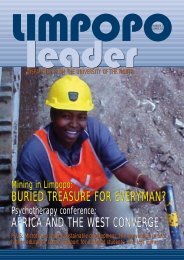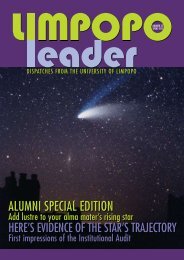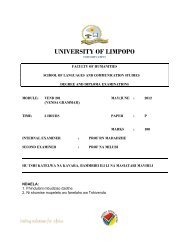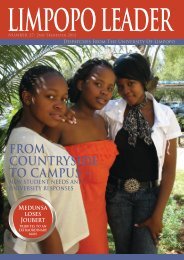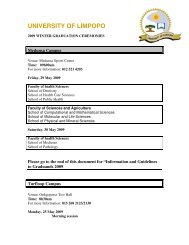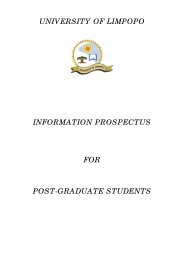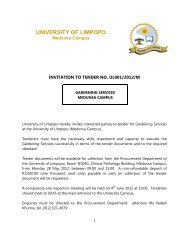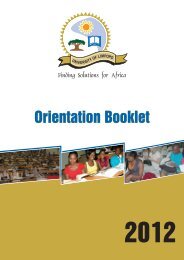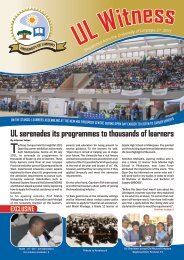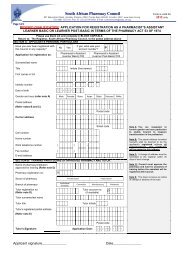You also want an ePaper? Increase the reach of your titles
YUMPU automatically turns print PDFs into web optimized ePapers that Google loves.
UNIVERSITY OF LIMPOPO<br />
TURFLOOP CAMPUS<br />
FACULTY OF SCIENCE AND AGRICULTURE<br />
SCHOOL OF AGRICULTURAL AND ENVIRONMENTAL SCIENCES<br />
DEGREE AND DIPLOMA EXAMINATIONS<br />
MODULE : PLNP451 MAY/JUNE : 2012<br />
(CITRUS PRODUCTION)<br />
TIME : 3 HOURS PAPER : P1<br />
INTERNAL EXAMINER : Mr. T.P. MAFEO (UL)<br />
EXTERNAL EXAMINER :<br />
MARKS : 100<br />
THIS PAPER CONSISTS OF …6…PAGES INCLUDING COVER PAGE<br />
INSTRUCTIONS:<br />
1. Answer all questions<br />
2. Write neatly and legibly<br />
3. Answer all questions in order <strong>of</strong> appearance
2<br />
PLNP451 MAY/JUNE EXAMINATION 2012<br />
QUESTION 1 [26]<br />
Discuss with the help <strong>of</strong> Figure 1 the physiological relationship between leafy<br />
versus leafless inflorences to citrus fruit bearing probabilities.<br />
QUESTION 2 [16]<br />
Briefly, outline the metabolic changes associated with growth and development<br />
<strong>of</strong> citrus fruit as shown on Figure 2.<br />
QUESTION 3 [11]<br />
Use the information supplied in a fertilization program for Midknight<br />
Valencia Sweet Oranges at Mahela Citrus Boerdery (Table 1) to calculate<br />
total amount <strong>of</strong> KCℓ required for September application. In your calculation,<br />
please ensure that all the steps are shown and convert the required amount<br />
into equivalent <strong>of</strong> 50 kg bags. Given that the orchard has 416 Midknight<br />
Valencia Sweet Oranges trees per ha and the specific orchard is 4 ha in<br />
size.<br />
QUESTION 4 [21]<br />
Briefly, elucidate how the different maturity parameters for citrus fruit are<br />
measured to ensure that export fruits meets minimum set maturity standards.<br />
QUESTION 5 [26]<br />
5.1. a) List the four South African citrus sectors. (2)<br />
b) State how much in total is each earning annual in foreign (5)<br />
excahnge?<br />
5.2 Which climatic conditions allow the production <strong>of</strong> wide range <strong>of</strong> citrus (4)<br />
types/sectors throughout South Africa?<br />
5.3 Name the different stakeholders and their responsibilities in South (13)<br />
Africa citrus industry that came as the results <strong>of</strong> deregulation <strong>of</strong> this
3<br />
industry in1997.<br />
PLNP451 MAY/JUNE EXAMINATION 2012<br />
5.4 Describe the three zones in which greening disease (3)<br />
(Huanglongbing) occur based on the severity <strong>of</strong> the disaese.
4<br />
PLNP451 MAY/JUNE EXAMINATION 2012<br />
Appendices<br />
Leafless flower shoot<br />
Leafless flower shoots<br />
Figure 1: Relationship between leafy versus leafless inflorences to citrus fruit<br />
bearing probabilities.<br />
Citrus flowering Shoots
5<br />
PLNP451 MAY/JUNE EXAMINATION 2012<br />
Figure 2: Metabolic changes associated with the growth and development citrus<br />
fruit. (B) Citrus fruit growth phases, (C) Chlorophyll degradation and carotenoid<br />
biosynthesis, (D) Soluble carbohydrates translocation and (E) Acid accumulation<br />
in fruit pulp.
6<br />
PLNP451 MAY/JUNE EXAMINATION 2012<br />
Table 1: A typical citrus fertilization program at Mahela Boerdery Letsitele on<br />
2012 production season, Tzaneen.<br />
Orchard: Orchard 20 Size: 4.0ha<br />
Cultivar/Variety: Midknight Valencias<br />
Oranges<br />
Trees per ha: 416<br />
Fertiliser Quantity Time <strong>of</strong> Application<br />
Soil Applications g per tree<br />
Limestone Ammonium Nitrate (LAN) 550 July<br />
LAN 250 August<br />
LAN 250 September<br />
Potassium Chloride (KCL) 550 September<br />
Dolomitic Lime 4000 October<br />
Foliar Sprays g/ 100ℓ water<br />
Low Biuret Urea 1000 July<br />
Manganese Sulphate 200 October<br />
Solubor® 150 October
7<br />
PLNP451 MAY/JUNE EXAMINATION 2012<br />
MEMO<br />
QUESTION 1 [26]<br />
Citrus fruit set is highly dependent upon the type <strong>of</strong> inflorescence (2). In general,<br />
leafless inflorescences emerge first (2) and contain a bouquet <strong>of</strong> flowers with low<br />
probability to set fruit (1). On the other hand, flowers in leafy inflorescences that<br />
can be terminal (2) or distributed among leaves along the shoot (2) are<br />
commonly associated with higher fruit set (2).<br />
Usually, late-opening flowers remain attached to the tree longer than earlyopening<br />
flowers (2) and flowering shoots with a high leaf-to-flower ratio have the<br />
highest fruit set (2). The positive influence <strong>of</strong> leaves on fruit set appears to be<br />
associated with increased net CO2 assimilation (2) and supply <strong>of</strong><br />
photoassimilates from developing leaves (2). These might also influence ovary<br />
growth (2) and fruit set (2) through the provision <strong>of</strong> gibberellins since leafy<br />
inflorescences contain higher hormonal levels than leafless ones (2).<br />
QUESTION 2 [16]<br />
The sub-figure B shows the three phases <strong>of</strong> citrus growth and development (1).<br />
Fruit growth is mostly due to cell divisions during phase I (1) and to water<br />
accumulation (1), and therefore cell enlargement, during phase II (1). At the<br />
beginning <strong>of</strong> phase III, growth is arrested (1) and fruit starts a non-climacteric<br />
ripening process (1). The sub-figure C shows decline in rind chlorophyll and the<br />
onset <strong>of</strong> carotenoid accumulation almost coincides with the disappearance <strong>of</strong><br />
chlorophyll (1). In contrast with peel flavedo, chlorophyll degradation and<br />
carotenoid biosynthesis in pulp proceed along phase II and therefore colour<br />
break is reached earlier (1). This results in a progressive change in pulp colour<br />
that contrasts with the rapid colour break occurring in flavedo (1). The sub-figure<br />
D shows the carbohydrates metabolical changes in the ripening citrus fruit (1).<br />
Paralleling fruit growth, high amounts <strong>of</strong> soluble carbohydrates are translocated<br />
to the developing fruit (1). Thus, mature citrus fruit pulp accumulates high
8<br />
PLNP451 MAY/JUNE EXAMINATION 2012<br />
amounts <strong>of</strong> sucrose, glucose and fructose (1) in a 2:1:1 ratio (1). The sub-figure<br />
E shows acid metabolic changes in ripening citrus fruit. (1). Acid accumulation in<br />
fruit pulp takes place during phase I and the beginning <strong>of</strong> phase II, reaching a<br />
maximum around mid-phase II (1). Organic acids are catabolized through the<br />
end <strong>of</strong> phase II (1) to attain during phase III the characteristic low acidity <strong>of</strong> ripe<br />
fruits (1).<br />
KCℓ Application in September<br />
QUESTION 3 [11]<br />
1. Number <strong>of</strong> trees in orchard = Orchard in size (ha) x Number <strong>of</strong> trees/ha<br />
= 4,0 ha x 46<br />
= 1164 trees in the orchad<br />
2. Total number <strong>of</strong> KCℓ required = KCℓ required/tree (grams) x Number <strong>of</strong> trees<br />
3. Conversion to kilogram (Kg)<br />
4. Conversion to 50kg bags<br />
in orchard<br />
= 550g x 1664 trees<br />
= 915 200g<br />
= 915 200g/1 000<br />
= 915,2kg<br />
= 915,2kg/50kg<br />
= 18 bags <strong>of</strong> 50kg <strong>of</strong> KCℓ<br />
QUESTION 4 [21]<br />
a) Fruit Colour (1)<br />
It is measured against a colour chart (1). In citrus industry, peel colour is not a<br />
reliable indicator <strong>of</strong> maturity (1). They are different charts used for the various<br />
types <strong>of</strong> citrus (1).
) Juice percentage (1)<br />
9<br />
PLNP451 MAY/JUNE EXAMINATION 2012<br />
It is determined by weighing a sample <strong>of</strong> twelve selected harvested fruit (1). The<br />
juice from these fruit is then extracted, filtered and weighed (1). Then, the juice<br />
percentage is determine by dividing juice weight with total weight <strong>of</strong> 12 sampled<br />
fruit (1).<br />
c). Total Soluble Solids (TSS)/Brix (Sugar content) (1)<br />
In citrus industry sugar content is known as °Brix (1), which is a measure <strong>of</strong> TSS<br />
in juice or concentrate (1). Brix is usually reported as “degrees brix” and is<br />
equivalent to percentage (e.g. citrus juice with 12 °Brix has 12 % TSS) (1). It is<br />
measured using refractometers (1), which are avalable in both hand-held and<br />
digital forms (1).<br />
d) Acid Content/ Titratable Acid (TA) (1)<br />
Citrus juice sourness is measured by volumetric titration with standardized<br />
sodium hydroxide, using phenolphthalein as internal indicator (1). This method<br />
measures mainly the citric acid, which is 70 to 90% <strong>of</strong> acid in the sample (1).<br />
e) Brix/Acid ratio (1)<br />
It is relative sweetness or sourness <strong>of</strong> citrus fruit (1), which is determined by ratio<br />
<strong>of</strong> sugars to acid (1). It is simple a quotient <strong>of</strong> °Brix divided by percentage TA (1).<br />
1.1. a. Sweet orange - 3 billion rand<br />
b. S<strong>of</strong>t citrus - 500 million rand<br />
c. Grapefruit - 600 million rand<br />
d. Lemon & limes - 400 million rand (6)<br />
QUESTION 5 [26]<br />
1.2. The climatic conditions that allow production <strong>of</strong> wide range <strong>of</strong> citrus<br />
types/sectors in SA are mild and almost frost-free winters, which range from
10<br />
PLNP451 MAY/JUNE EXAMINATION 2012<br />
latitudes 17°S to 34°S where temperature is seldom drops below - 20C and<br />
almost never - 30C. (4)<br />
1.3. a. Citrus Growers Association – it is responsible for research, playing a role<br />
in transformation, information and market access.<br />
b. Citrus Exporters Forum – it is established to look at the export side and what<br />
is going on market.<br />
c. Citrus Academy – it is responsible for training and skills development in the<br />
citrus sector.<br />
d. Citrus Research International – it does research work and looks at the<br />
technical side <strong>of</strong> market access. (13)<br />
1.4 a) Zone A, which is regarded as where highest incidence <strong>of</strong> the diseases<br />
occurs<br />
b) Zone B, where the incidence <strong>of</strong> greening is moderate<br />
c) Zone C, where the incidence <strong>of</strong> grening disease is low (3)
UNIVERSITY OF LIMPOPO<br />
TURFLOOP CAMPUS<br />
FACULTY OF SCIENCE AND AGRICULTURE<br />
SCHOOL OF AGRICULTURAL AND ENVIRONMENTAL SCIENCES<br />
DEGREE AND DIPLOMA (SUPPLEMENTARY/AEGROTAT) EXAMINATIONS<br />
MODULE : PLNP451 MAY/JUNE : 2012<br />
(CITRUS PRODUCTION)<br />
TIME : 3 HOURS PAPER : P1<br />
INTERNAL EXAMINER : Mr. T.P. MAFEO (UL)<br />
EXTERNAL EXAMINER :<br />
MARKS : 100<br />
THIS PAPER CONSISTS OF …3…PAGES INCLUDING COVER PAGE<br />
INSTRUCTIONS:<br />
1. Answer all questions<br />
2. Write neatly and legibly<br />
3. Answer all questions in order <strong>of</strong> appearance
2<br />
PLNP451 MAY/JUNE (SUPPLEMENTARY/AEGROTAT)<br />
EXAMINATION<br />
QUESTION 1 [32]<br />
2012<br />
1.1. a) On which factors are packhouse designs based? (5)<br />
b) Name three major citrus fruit market segments. (6)<br />
c) Enlist five major fundamental operations that need to be perform<br />
in citrus fruit packhouse. (10)<br />
d) On which stages/steps <strong>of</strong> citrus fruit packhouse is fungicide<br />
applied? (4)<br />
1.2. a) What is de-greening process? (2)<br />
b) Enlist five factors that contribute to de-greening atmosphere in the<br />
de-greening room. (5)<br />
QUESTION 2 [15]<br />
2.1. Explain in your own words what you understand by maximum<br />
residue levels. (5)<br />
2.2. Where can citrus growers and packhouses find more information<br />
about MRLs? (4)<br />
2.3. Where can growers and packhouses find more information<br />
about citrus fruit packing specifications? (2)<br />
2.4. Which two factors are used by the Perishable Products Export and<br />
Control Board (PPECB) inspectors when they come onto the farm<br />
into the packhouse to do inspections? (4)<br />
QUESTION 3 [13]<br />
3.1. a) What is the significance <strong>of</strong> citrus rind scarring in fruit quality?, (5)<br />
b) Give three major causes <strong>of</strong> citrus fruit rind scarring (6)<br />
c) And for each provide one example as differentiated by their<br />
symptoms.<br />
(2)
3<br />
PLNP451 MAY/JUNE (SUPPLEMENTARY/AEGROTAT)<br />
EXAMINATION<br />
QUESTION 4 [40]<br />
4.1. What are the climatic descriptions <strong>of</strong> the following climatic zones<br />
suitable for citrus production in South Africa?<br />
2012<br />
a. Semi-desert regions (3)<br />
b. Cold production regions (3)<br />
c. Cool, inland production regions (2)<br />
d. Intermediate production regions (3)<br />
e. Hot production regions (4)<br />
4.2. Discuss pre-planting fertilisation phase as one <strong>of</strong> the three phases <strong>of</strong><br />
a citrus fertilization program. (16)<br />
4.3. Briefly explain the main objectives <strong>of</strong> performing proper training and<br />
pruning as cultural practices in citrus trees. (9)<br />
MEMO<br />
QUESTION ONE [32]
4<br />
PLNP451 MAY/JUNE (SUPPLEMENTARY/AEGROTAT)<br />
EXAMINATION<br />
1.1 a) 1. Quantity <strong>of</strong> fruits (1),<br />
2. Cultivar/type <strong>of</strong> citrus being packed (1),<br />
3. Requirements <strong>of</strong> growers, whose fruit are being packed (1),<br />
4. Markets that fruit will go to (1) and<br />
5. Available manpower (1).<br />
b) 1. Export market (2)<br />
2. Local market (2)<br />
3. Juice processing market (2)<br />
c) 1. Separating fruit – according three major market segments (2)<br />
2012<br />
2. Applying treatments and process – packhouse must design way that right<br />
treatment and process are applied to right fruit at right time (2)<br />
3. Meet market requirements – packhouse must ensure that the process and<br />
package right fruit as per market destined for (2)<br />
4. Enable tracing and tracking – packhouse process needs to ensure traceability<br />
<strong>of</strong> fruit throughout flow (2)<br />
5. Fruit quality and safety – quality and safety <strong>of</strong> fruit must always be maintained<br />
through the flow (2)<br />
d) 1. Dumping site (2)<br />
2. Fungicide washing bath (2)<br />
1.2. a) It is the process <strong>of</strong> enhancing citrus fruits colour from green to yellow,<br />
which is more desirable colour.<br />
b) Ethylene (1), temperature (1), humidity (1), air circulation (1) & ventilation and<br />
atmospheric composition (1)<br />
QUESTION 2 [15]<br />
2.1. MRLs are defined as the maximum concentration <strong>of</strong> pesticide residue<br />
(expressed as milligrams <strong>of</strong> residue per kilogram <strong>of</strong> food/animal feeding stuff)<br />
likely to occur in or on food and feeding stuffs after the use <strong>of</strong> pesticides<br />
according to Good Agricultural Practice (GAP), i.e. when the pesticide has been<br />
applied in line with the product label recommendations and in keeping with local
5<br />
PLNP451 MAY/JUNE (SUPPLEMENTARY/AEGROTAT)<br />
EXAMINATION<br />
2012<br />
environmental and other conditions). MRLs are primarily trading standards, but<br />
they also help ensure that residue levels do not pose unacceptable risks for<br />
consumers (5).<br />
2.2. Citrus Growers Association (2) and Citrus Research International (2)<br />
2.3. Department <strong>of</strong> Agriculture, Forestry and Fisheries (DAFF) (2)<br />
2.4. The first factor relates to general requirements, and these in fact will apply to<br />
all citrus fruits (2). The second factor refers to internal and external quality<br />
standards (2).<br />
QUESTION 3 [13]<br />
3.1. a) Citrus fruit rind scarring is important in fruit quality since fruit with scarring<br />
symptoms are culled and downgraded during pre-sorting and packaging stages<br />
in the packhouse (3). Furthermore, citrus fruit with scars are susceptible to<br />
postharvest decaying as result <strong>of</strong> easy entry by microorganisms (2).<br />
b) The three major causes <strong>of</strong> citrus fruit scarring are biological (2), mechanical<br />
(2) and chemical damages (2) and c) their examples are biological (insects,<br />
mites and diseases) (1), mechanical (wind, hail and equipment) (1) and chemical<br />
(phytotoxic burn) (1).<br />
QUESTION 4 [40]<br />
4.1. a. Semi-desert regions – these areas are characterised by extreme hot<br />
summers (1) and cold winters (1) with the occurrence <strong>of</strong> frost (1)<br />
b. Cold production regions – these are semi-coastal areas situated in southern<br />
latitudes (1), between 23°30’and 34°30’S (1) in Eastern, Southern and Western<br />
Cape (1)<br />
c. Cool, inland production regions – occurs on high-lying areas (1) (above 900 m<br />
elevation) (1)<br />
d. Intermediate production regions- falls between hot, low-lying areas (1) and<br />
cool, high-lying areas (1), i.e. between 600 and 900 m elevation (1)
6<br />
PLNP451 MAY/JUNE (SUPPLEMENTARY/AEGROTAT)<br />
EXAMINATION<br />
2012<br />
e. Hot production regions- these are areas with-hot humid(1) (< 300 m elevation)<br />
(1) & hot dry (1) (300-600 m elevation) (1)<br />
4.2. Soil Preparation & Pre-Plant Fertilization<br />
• Before establishing citrus orchard it essential to prepare soil correctly.<br />
• Soil suitability & correct method soil preparation can determine by<br />
inspecting soil pr<strong>of</strong>ile pit.<br />
Liming<br />
• Lime requirement determine by timeous soil analysis before soil<br />
preparation.<br />
• It depends on level soil acidity (between 6.0 & 7.2).<br />
• If liming recommended based soil analysis, two possible limes (dolomitic<br />
or calcitic) can used.<br />
• Depending on calcium & magnesium ratio in soil, anyone can use.<br />
• Lime should applied 3-6 months prior planting<br />
• When applying lime should broadcast and deeply ploughed-in (500-<br />
600mm)<br />
Phosphorus requirement<br />
• Since P immobile element needs incorporated prior planting<br />
• If supers used, about 1000 kg/ha should applied.<br />
• Methods to apply P:<br />
1. Strip application<br />
2. Ridges<br />
3. Planting hole<br />
4.3. 1. To control pests and diseases in the citrus orchard by remove diseased<br />
branches and encouraging air circulation.<br />
2. To increase the leaf the total effective leaf area and promote photosynthesis<br />
by exposing the leaves light and air.<br />
3. To keep the tree in the right size, so that the grower can easily manage his<br />
orchard.
7<br />
PLNP451 MAY/JUNE (SUPPLEMENTARY/AEGROTAT)<br />
EXAMINATION<br />
2012



